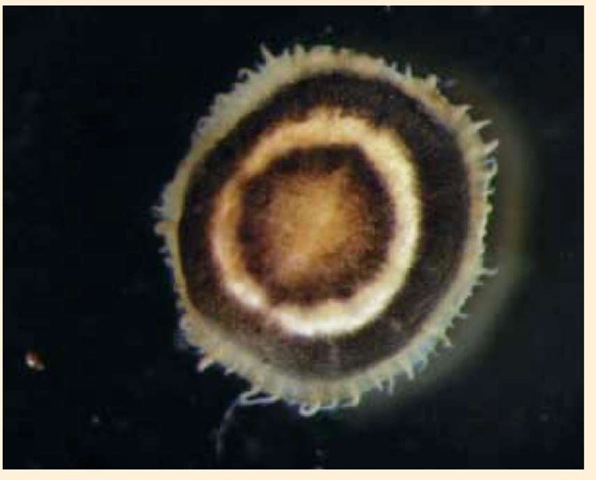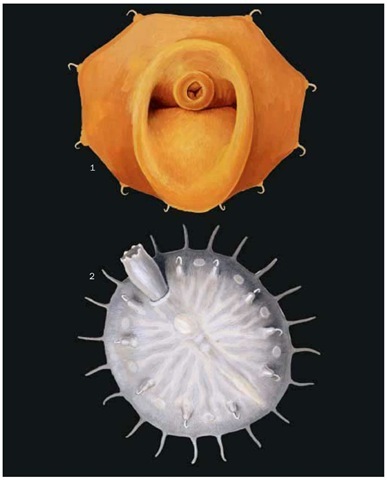Number of families 8
Thumbnail description
Minute, soft-bodied marine worms associated with echinoderms
Photo: A dorsal view of Myzostoma polycyclus, collected on a crinoid from Madagascar.

Evolution and systematics
The name “myzostomid” comes from the Greek myzo, meaning “to suck,” and stoma, meaning “mouth.” Leuckart described the first myzostomid, Myzostoma parasiticum, in 1827 and 1836. Since that discovery, the phylogenetic position of myzostomids within the metazoans has been a subject of controversy. The early assignments of myzostomids to Trematoda, then to Crustacea or Stelechopoda (a taxon grouping myzostomids with Tardigrada and Pentastomida), are no longer considered valid. Because myzostomids exhibit characters such as parapodia with chaetae, trochophore-type larvae, and segmentation (although incomplete), they are now classified in text topics as a family of Poly-chaeta or as a class of Annelida (the latter classification is followed here). However, phylogenetic analyses, including that of myzostomid DNA sequences, strongly support the view that they are not annelids but a phylum closely related to the flatworms.
The class Myzostomida is divided in two orders and eight families: the order Proboscidea (Myzostomatidae); and the order Pharyngidea (Protomyzostomatidae, Asteromyzos-tomatidae, Asteriomyzostomatidae, Endomyzostomatidae, Stelechopidae, Pulvinomyzostomatidae, and Mesomyzos-tomatidae). There are about 170 species.
Physical characteristics
The body of most myzostomids consists of an anterior cylindrical introvert (also called a proboscis) and a flat, disk-like trunk. The introvert is extended when the individual feeds, but it is retracted into an anteroventral pouch within the trunk most of the time. The trunk ranges in length from 0.118 in (3 mm) to 1.181 in (3 cm) for the largest species. There are usually five pairs of parapodia, located lateroven-trally in two rows; each parapodium contains a protrusible hook, some replacement hooks, and a support rod, or acicu-lum. Most species have four pairs of slitlike or disklike lat-eroventral sense organs, commonly named lateral organs, and the trunk margin often bears needlelike cirri (more than 100 in some species). In a few species, humplike cirri occur at the base of each parapodium. Two male gonopores are located at the level of the third pair of parapodia; the female gonopore opens close to the anus, posteroventrally.
When myzostomids are parasitic, their body is often highly modified. The introvert, external appendages, and sensory organs are usually reduced or have disappeared. According to the location of myzostomids in the host, their trunk may be pleated dorsally, mushroom shaped, or irregular in shape.
Distribution
Myzostomids are found in all oceans from shallow waters to depths of over 9,840 ft (3,000 m). Most occur in tropical waters, but a few are found in the Arctic and Antarctic Oceans.
Habitat
These marine animals live in association with echinoderms.
Behavior
All myzostomids live in association with echinoderms. Most species (90% of myzostomids) are ectocommensals of crinoids, but a few are parasites of crinoids, asteroids, or ophi-uroids, infesting their gonads, coelom, integumental, or digestive systems. The association between myzostomids and echinoderms is ancient, and signs of parasitic activities, similar to those induced by extant parasitic myzostomids, are found in fossilized crinoid skeletons dating back to the Carboniferous period.
Feeding ecology and diet
Very few myzostomids feed on host tissues or coelomic fluid, most feed on particles that they divert from the host using their introvert. Crinoids, the main hosts, are suspension feeders, catching food particles in the water column with podia on both sides of the ciliated grooves that run along their arms. When myzostomids want to feed, they insert their introvert into these ciliated grooves and suck up water and food particles into their mouth.
Reproductive biology
Most myzostomids are hermaphroditic. They are often functional simultaneous hermaphrodites, even though the male genital system develops a bit earlier than the female genital system during organogenesis. In some species, both males and females occur, and are often interpreted as the two stages of protandrous hermaphroditic species, the dwarf male apparently transforming into a female once it lives alone.
Reproduction in myzostomids takes place by the emission of spermatophores followed by the intradermic penetration of sperm cells. In ectocommensals, mating involves two mature individuals that contact each other, one individual ejecting one spermatophore that attaches to the integument of the other. Contact between the two individuals is very brief and they separate quickly after mating. Spermatophores generally attach to the back of the receiver, but they can be emitted successfully onto any body part.
Depending on the species, the emitted spermatophores may be white V-shaped, club-shaped, or ball-shaped baskets. After attachment, they pierce the integument and release all the sperm cells into it. Penetration can be observed, thanks to the presence of the white trails produced by the sper-matophore contents extending into the translucent body of the receiver. These trails appear from 10 to 30 minutes after attachment of a spermatophore, and after from one to five hours, the spermatophores are reduced to an empty matrix. Fertilization of mature oocytes is internal, and eggs are accumulated into a uterus before being laid. Division is spiral, occurring in the water column, and gives rise to free-swimming trochophore larvae.
Conservation status
No species of myzostomids are listed by the IUCN.
Significance to humans
No parasitic myzostomids infest humans or animals reared by humans. They have no impact on human health.

1. Pulvinomyzostomum pulvinar, 2. Myzostoma cirriferum.
Species accounts
No common name
Pulvinomyzostomum pulvinar
ORDER
Pharyngidea
FAMILY
Pulvinomyzostomatidae
TAXONOMY
Pulvinomyzostomum pulvinar von Graff, 1884, “in the Minch, from 60 to 80 fathoms.”
OTHER COMMON NAMES
None known.
PHYSICAL CHARACTERISTICS
Females with stout trunk up to 0.16 in (4 mm) long with lateral margins folded upward and inward so dorsal surface is partly depressed; no introvert but a protrusive pharynx; both mouth and anus dorsal. No cirri, but 10 pairs of slitlike lateral organs with 5 pairs of reduced parapodia. Males with flattened, ovoid trunk up to 0.06 in (1.5 mm) long. Six pairs of lateral organs; 5 pairs of papilliform parapodia. No cirri.
DISTRIBUTION
Mediterranean Sea; northeast Atlantic Ocean along coasts of Europe.
HABITAT
Live in shallow and deep sea marine waters.
BEHAVIOR
Endosymbiont of shallow-water crinoids Antedon bifida, Lep-tometra phalangium, and L. celtica. Parasitic or commensal. Female generally infests anterior part of the crinoid digestive system with a male on its flank.

FEEDING ECOLOGY AND DIET
Feeds on particles in crinoid digestive system.
REPRODUCTIVE BIOLOGY
Protandrous hermaphrodite. Males transform into females when they live alone. Reproductive process unknown.
CONSERVATION STATUS
Not listed by the IUCN.
SIGNIFICANCE TO HUMANS
None known.
No common name
Myzostoma cirriferum
ORDER
Proboscidea
FAMILY
Myzostomatidae
TAXONOMY
Myzostoma cirriferum Leuckart, 1836, Mediterranean Sea.
OTHER COMMON NAMES
None known.
PHYSICAL CHARACTERISTICS
Flattened, ovoid trunk, up to 0.09 in (2.4 mm) long; cylindrical introvert of 0.04 in (1 mm) long (fully extended). Parapodia, lateral organs, and penises well developed, all ventrally located. Ten pairs of marginal cirri.
DISTRIBUTION
Mediterranean Sea; northeast Atlantic Ocean along coasts of Europe.
HABITAT
Live in shallow and deep sea marine waters.
BEHAVIOR
Ectocommensals of the shallow-water crinoids Antedon bifida, A. petasus, A. adriatica, A. mediterranea, and Athrometra prolixa. Several hundred can infest a single crinoid.
FEEDING ECOLOGY AND DIET
Feeds on particles diverted from the ambulacral grooves of crinoids.
REPRODUCTIVE BIOLOGY
Simultaneous hermaphrodite. Reproduces year round by transfer of spermatophores and intradermic penetration of sperm cells.
CONSERVATION STATUS
Not listed by the IUCN.
SIGNIFICANCE TO HUMANS
None known.
